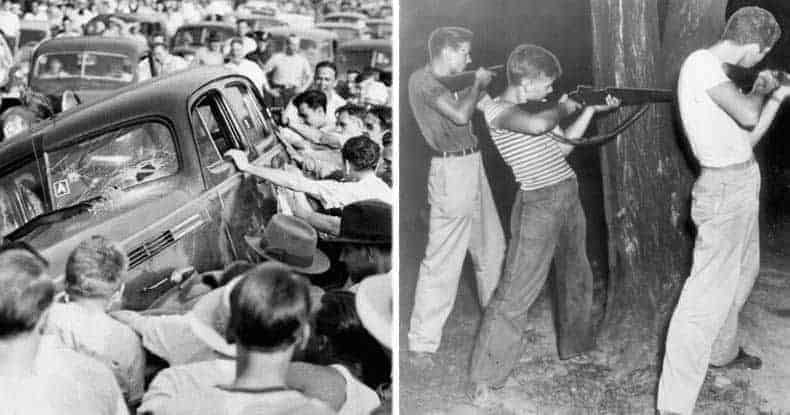When watching movies, we have to willingly suspend disbelief, at least to some extent, in order to enjoy the film. However, a common criticism of many movies is that their plots are just too unrealistic and farfetched. Sometimes, though, real life offers up actual events that are just as ridiculous and seemingly farfetched as any tacky B-movie.
Following are ten real life stories that could make for a crazy movie plot.
Returning WW2 Veterans Rose in Armed Rebellion Against a Corrupt Southern Sheriff in 1946
When WW2 ended, most American veterans were welcomed back with parades or at least the warm embrace of a grateful nation. Not so, the veterans of Athens, Tennessee, who returned to the nightmare of a corrupt local Sheriff. However, having just finished kicking the behind of tyrannies overseas, they were not about to submit to tyranny at home: so they took up arms and went to war.
Athens was the seat of McMinn County, TN, which had fallen into the clutches of a dirty political machine, venal even by the then-prevailing standards of southern local governments. The Sheriff’s income depended on the number of prisoners in his jail, so he engaged in predatory policing to keep his jail full. People were routinely victimized by overbearing deputies, looking for any excuse to throw somebody in jail. If they were unable to find something, the Sheriff and his deputies would simply beat up a victim, then toss him in jail for “resisting arrest”.
Complaints were unavailing, as local officials and the local judge were just as dirty. The entire government machinery was on the take, getting a cut from various illicit activities, from moonshine stills to misappropriation of public funds. And presiding over it all was the Sheriff, who turned a blind eye to official corruptions, and acted as enforcer to intimidate dissenters.

Things got worse during the war: with nearly the entire fit male population in uniform and away, the Sheriff’s deputies had a free run of the local females. As they endured the depredations, “wait ’til the boys get back!” became a mantra amongst the locals. As the vets drifted back home, the determined to change things. So they formed “The GI Nonpartisan Party” to contest the elections scheduled for August 2nd, 1946. With all county offices on the line, especially that of Sheriff, the stakes were high. The veterans were confident of victory. The incumbents were equally confident: who counts the votes matters more than who votes, so all they had to do was control the ballot boxes.
Thus, the election hinged on the poll watchers: Sheriff’s deputies for the incumbents, and veterans for the challengers. Trouble began when a black man tried to vote at an Athens precinct, only for deputies to shoot him on the spot. They then shut down the voting precinct, and held the veterans’ poll watchers captive. Soon, the Sheriff and other deputies arrived, sirens blazing, to seize the ballot boxes and move them to the jail. Word then spread throughout the county that voting was to be cancelled, and all ballot boxes were to be taken to the jail.
Suddenly, it was put up or shut up time, as the Sheriff and about 200 deputized henchmen barricaded themselves with the ballot boxes in the fortress-like county jail. The veterans decided to put up. About 45 seized the local armory and the weapons therein, and headed to the jail for a showdown. Although heavily outnumbered, the veterans had the advantage of military training, and many had recent combat experience. So they seized the tactical advantage by seizing a ridge overlooking the jail. When night fell, gunfire suddenly erupted from the jail, and what came to be known as “The Battle of Athens” ensued.
The violence escalated when a veteran blew up the jail’s front with dynamite. That was when the goons inside realized that they were faced with a level of violence that their years of bullying defenseless civilians had not prepared them for. White flags were stuck out of the jail’s windows, and the corrupt officials and their henchmen surrendered. The ballot boxes were recaptured, and by sunrise the following morning, they had been counted: The GI Nonpartisan Party won in a landslide.

